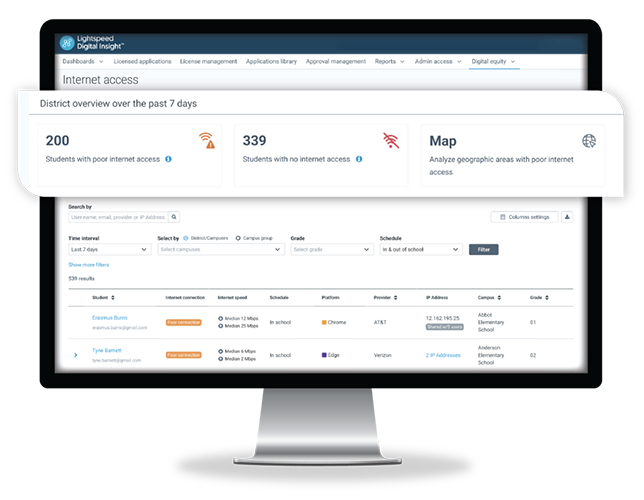New Network Tool Measures Students' Connectivity Off-Campus
- By Kristal Kuykendall
- 06/08/23
K–12 network management provider Lightspeed Systems has launched a solution to help schools ensure students stay connected to learning regardless of where they’re studying.
The new Digital Equity module provides real-time connectivity and device health data on students’ school-issued devices, enabling school leaders to know when students experience connectivity outages at home — allowing for interventions or assistance before learning outcomes are impacted, Lightspeed Systems said in a news release.
The Digital Equity module is an extension of Lightspeed Systems’ Digital Insight network and ed tech analytics platform, “taking the guesswork out of understanding how students are using digital tools off-campus,” the company said.
Consortium for School Networking reported in its 2022 Student Home Connectivity Study that across the United States, gaps persist in network performance and internet speeds for students of all grades connecting from off-campus; CoSN said that about a third of high-schoolers have home connectivity that falls below minimum requirements for online learning. The study also found that “large disparities exist among student subgroups, particularly by ethnicity and socioeconomically disadvantaged students,” presenting further inequities in educational access and outcomes.
Digital Equity gives school IT staff and admins a real-time view of each student’s school-issued devices, including a device’s overall health, operating system, internet speed, service provider, and more, the company said. “Leaders can drill-down into specific data on each individual student and their devices, as well as view overall district-wide usage to help identify local communities that need additional support and resources,” the announcement said. The solution is customizable, with the option for school staff to select the data and usage stats they want to see.
“Lightspeed Systems’ Digital Equity will help us bridge the digital divide in the communities that our schools serve, ensuring we determine which students need additional resources, like hotspots and more,” said Oklahoma City Public Schools IT Director Eric Hileman, who uses Lightspeed to monitor and manage his district’s devices and has been beta testing the Digital Equity module. “Ensuring each one of our students has consistent access to the internet after school is paramount to our teaching and learning goals.”
Examples of ways that Digital Equity’s insights empower school leaders before connectivity gaps impact learning outcomes include:
Identify students experiencing poor or no internet connection outside of school without waiting for an IT ticket, self-reporting, or annual family surveys
Address issues in real-time and more quickly troubleshoot school-issued devices with student-level data, including internet speeds at home, service providers and more.
Make data-informed decisions about students’ access to broadband and potential local intervention programs such as hotspots, Wi-Fi enabled community centers, etc.
Learn more at LightspeedSystems.com.

About the Author
Kristal Kuykendall is editor, 1105 Media Education Group. She can
be reached at [email protected].